
You’re at the right place if you want to know what skill levels are required for various jobs in Australia and New Zealand. A strong framework that establishes the categorization and skill criteria for a broad range of occupations is the Australian and New Zealand Standard Categorization of Occupations (ANZSCO) system.
This blog offers a thorough summary of how skill categories influence the work environment in these two countries, regardless of whether you’re professional, thinking about changing careers, an ambitious immigrant, or someone curious about the ANZSCO skill level standards.
Table of Contents
Introduction to ANZSCO
Australia and New Zealand worked together to create the skill-based Australian and New Zealand Standard Classification of Occupations (ANZSCO).
It offers a structured approach to classify professions according to the expertise needed, establishing a common framework for evaluating credentials, proficiencies, and work history. The ANZSCO system assists companies, government organizations, and immigrants in identifying the skill needs for different occupations.
Purpose of ANZSCO Classifications
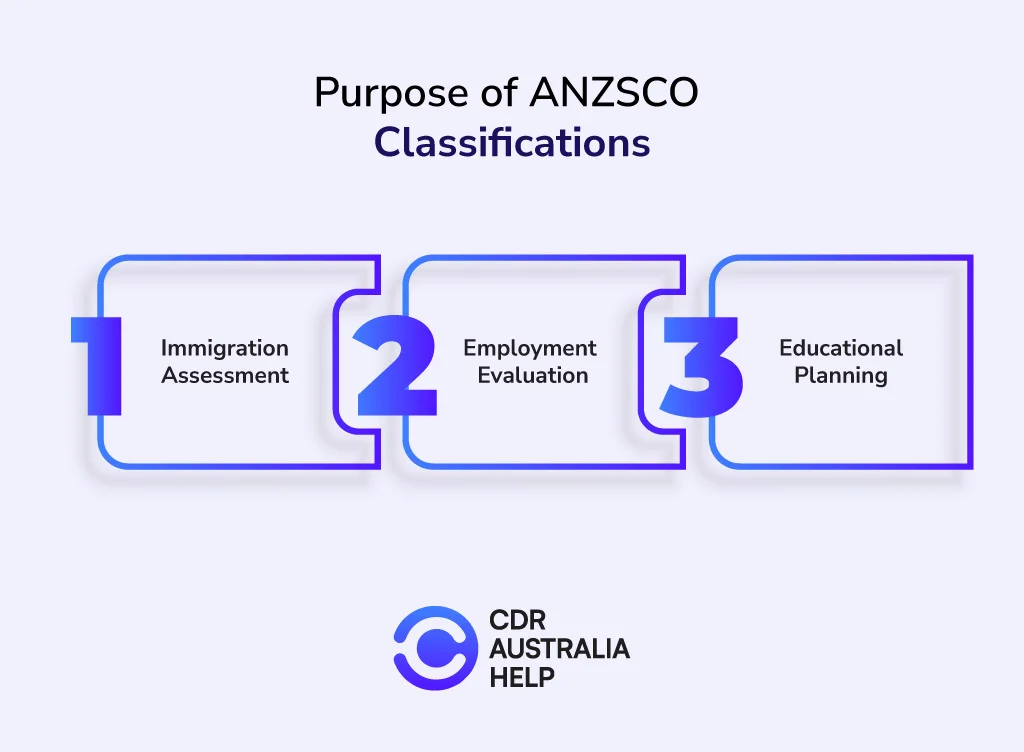
ANZSCO classifications serve several purposes:
- Immigration Assessment
To determine eligibility for migration paths to Australia and New Zealand, ANZSCO’s skill levels are essential since they aid in evaluating whether an applicant’s vocation matches market needs.
- Employment Evaluation
ANZSCO categories help employers better define job responsibilities by assessing the abilities and credentials needed for a position.
- Educational Planning
To bridge the gap between education and market demands, students and training institutions use ANZSCO categories to create curricula that correspond with particular skill requirements.
Through these uses, ANZSCO skill levels have become a critical tool for workforce planning, education, and skilled migration.
The Structure of ANZSCO: Major Groups to Occupations
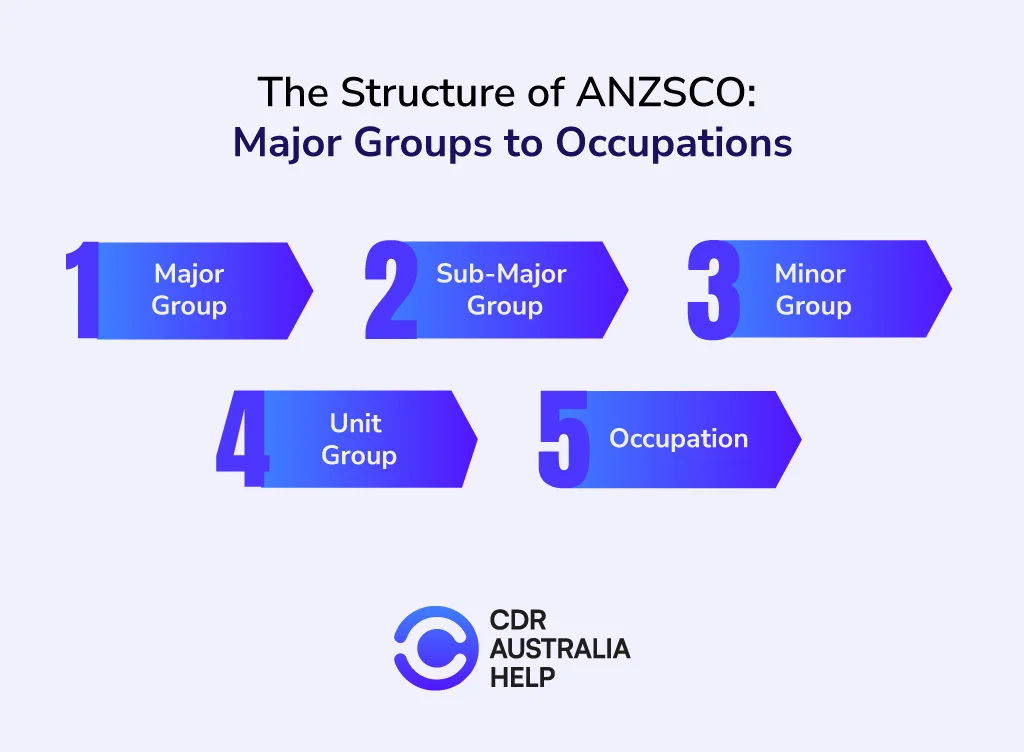
ANZSCO is organized into a hierarchical structure with five levels, designed to categorize jobs by the similarity in skill levels and specializations:
- Major Group
the most inclusive categorization level, integrating industry-specific specialism and skill level.
- Sub-Major Group
Subdivisions of major groups focus on professions with broad specialties and comparable skill sets.
- Minor Group
a more focused division of sub-major categories according to certain skill applications.
- Unit Group
Unit groups concentrate on applying skill specializations more precisely. To help professionals understand how their function fits into larger occupational categories, an ANZSCO unit group contains roles that share numerous responsibilities and essential activities.
- Occupation
Individual work positions with distinct skill specialties and task requirements are defined at the most comprehensive level.
Understanding these levels is essential for anyone looking to interpret ANZSCO data accurately.
Understanding ANZSCO Skill Levels
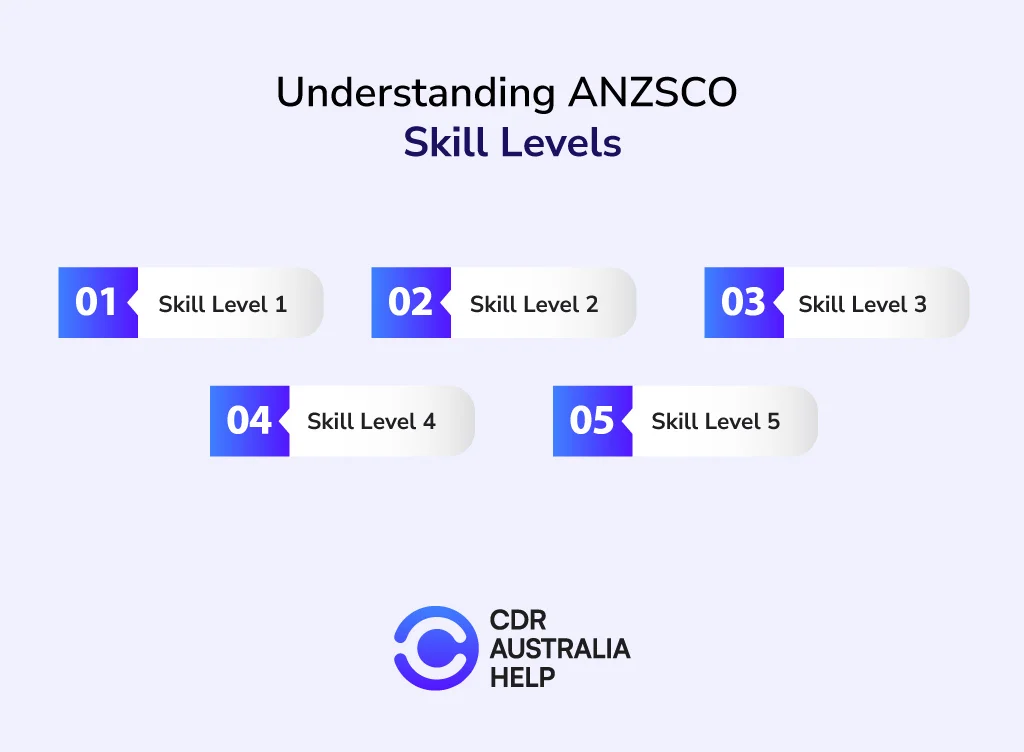
ANZSCO skill levels categorize occupations based on the complexity and expertise required for each role. Each occupation is assigned a skill level from 1 (highest skill level) to 5 (lowest skill level). This classification reflects the education, training, and experience typically required:
- Skill Level 1
Occupation at this level requires a high level of knowledge and abilities; you frequently need years of experience and a bachelor’s degree or above. Management occupations, professional services positions, and specialist technical positions are a few examples.
- Skill Level 2
Occupations at this level often need a few years of experience in addition to a diploma or comparable certification. This category includes positions in industries such as health and support services.
- Skill Level 3
These occupations, which often comprise positions in technical and trade sectors like manufacturing or construction, frequently require an NZ Register Level 4 certification and appropriate work experience.
- Skill Level 4
Occupations like clerks, drivers, and assistants in various industries usually require NZ Register Level 2 or Level 3 certificates and little work experience.
- Skill Level 5
The least specialized roles require only secondary education or on-the-job training, such as retail workers and process workers in manufacturing.
Skill Level Requirements and Educational Qualifications
Each ANZSCO skill level is associated with specific educational requirements. The educational expectations are aligned with the Australian Qualifications Framework (AQF) and the New Zealand Qualifications Framework (NZQF), both of which set standards for formal education in the region.
This alignment helps ensure that education aligns with the complexity of job tasks, contributing to a more qualified workforce.
The educational requirements for each skill level include:
- Skill Level 1
Bachelor’s degree or higher, typically paired with relevant work experience.
- Skill Level 2
Diploma or equivalent qualifications, with prior experience beneficial.
- Skill Level 3
NZ Register Level 4 qualification and suitable training.
- Skill Level 4
NZ Register Level 2 or 3 qualification, usually accompanied by shorter on-the-job training.
- Skill Level 5
NZ Register Level 1 of compulsory secondary education or brief training upon joining.
Work Experience and Skill Levels
Work experience is a key factor in skill categorization for those looking for a job in Australia using the ANZSCO system.
Workers in occupations classified under ANZSCO unit groups are required to carry out particular duties and obligations with competence, which is usually attained via years of relevant experience.
Skill levels 1, 2, and 3 sometimes require substantial experience in similar disciplines to comprehend the task’s complexity completely. Matching one’s expertise to the definition of an ANZSCO unit group can significantly impact one’s eligibility for skilled migration to Australia.
Furthermore, every degree of experience helps build proficiency, particularly in fields requiring technical know-how or managerial abilities.
Explaining Skill Level 1 in Australia
So, what is Skill Level 1 in Australia? Occupations at Skill Level 1 represent the highest level of expertise, requiring advanced education and professional experience. These roles include managers, technical experts, and specialized professionals.
Examples include positions requiring advanced degrees (typically postgraduate) and substantial work experience, such as university teachers, IT managers, and surgeons.
Additionally, Skill Level 1 responsibilities typically involve more responsibility, decision-making power, and leadership within companies.
As one of the most prominent categories within ANZSCO, Skill Level 1 roles require candidates to fulfill strict educational and experience criteria.
Significance of ANZSCO Unit Groups
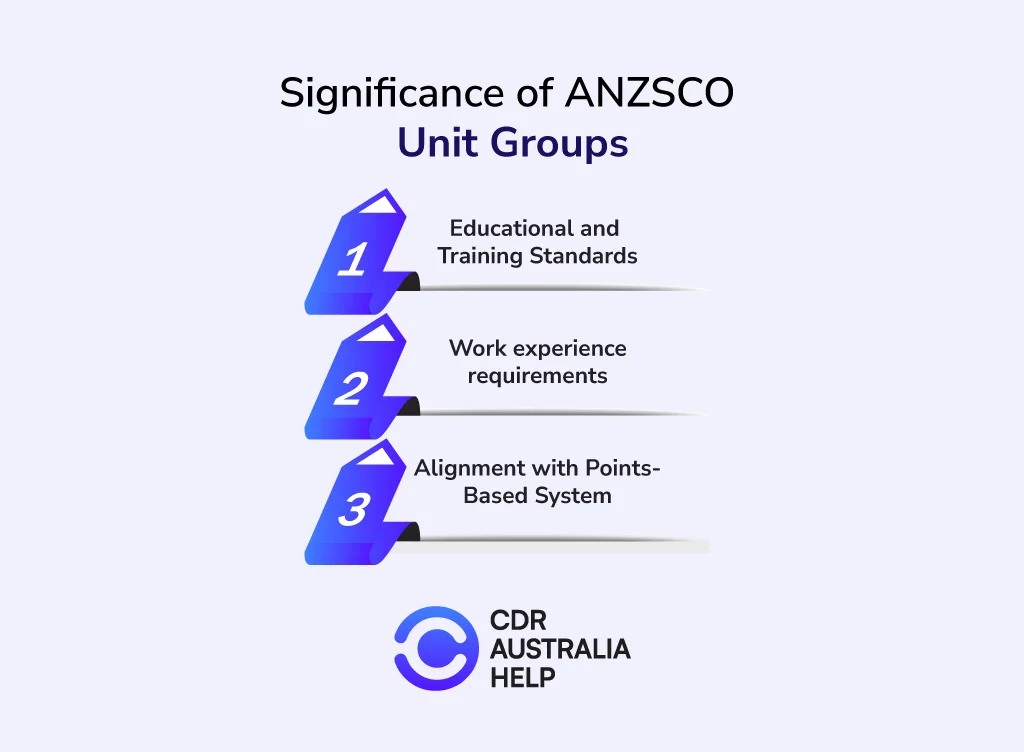
By combining similar professions, ANZSCO unit groups enable more accurate skill classifications.
Unit Group 1421, for instance, classifies retail managers, which includes jobs like “Pharmacy Manager” and “Retail Store Manager.”
It is simpler for employers and immigration authorities to evaluate qualifications uniformly when unit groupings are used to define duties, essential competencies, and experience in related jobs.
A standardized skill-based approach to workforce planning is created by each unit group, which offers information on the fundamental duties, necessary skills, and educational background for each position.
Every occupation is given a skill level by ANZSCO, ranging from 1 to 5, where most specialist tasks are represented by skill level 1, and more broad occupations are covered by skill level 5.
These skill levels show the education, credentials, and work history normally needed for the occupation.
- Educational and Training Standards
The minimal training and educational requirements are outlined in the ANZSCO skill levels. For instance, a bachelor’s degree or beyond is often required for Skill Level 1, although simply on-the-job training may be necessary for Skill Level 5.
- Work experience requirements
Each skill level indicates the amount of work experience needed in addition to formal education. For example, a Skill Level 3 occupation may require fewer years of experience than a Skill Level 1 occupation, which usually requires five or more years.
- Alignment with Points-Based System
Since credentials and experience are important considerations in the points evaluation process, fulfilling the skill level requirements may affect the number of points an applicant earns under Australia’s points-based visa system.
The ANZSCO skill level framework helps establish a clear benchmark for assessing the skill requirements of each occupation, providing a standardized basis for visa eligibility.
Migration and ANZSCO Classifications
ANZSCO classifications play a crucial role in establishing eligibility for migrants. Migration officials evaluate candidates according to how well their credentials and experience match the competence level specified by ANZSCO.
Ensuring that your employment and credentials closely align with an ANZSCO unit group with the necessary skill level is crucial for success in the skilled migration process.
In order to properly understand these categories and improve their prospects of a successful migration outcome, many candidates seek advice from professionals.
ANZSCO, or the Australian and New Zealand Standard Classification of Occupations, provides a structured system that aligns an individual’s work experience and qualifications with the occupational needs of these countries.
This system is crucial for determining a candidate’s eligibility for migration, helping them navigate the complexities of choosing the right career, and understanding the associated skill levels.
The Role of ANZSCO Classifications in Migration
Australia and New Zealand developed ANZSCO as a way to evaluate labor market needs and ensure that skilled migration aligns with their economic priorities.
The system allows these countries to review and assess applicants based on their occupation, skills, and qualifications.
- Skills Lists and Occupational Demand
Skilled Occupation Lists (SOL), which highlight talent gaps across a range of industries, are routinely released by both nations. These listings include jobs that fit the region’s particular economic demands and are categorized under ANZSCO.
Certain visas are available for in-demand jobs, giving qualified professionals the chance to move if their background fits the list of ANZSCO occupations.
- Benchmark for Qualifications and Experience
The ANZSCO system defines the minimum qualifications and work experience needed for different occupations.
These criteria serve as the foundation for applicants’ eligibility for skilled visas by enabling migration authorities to ascertain if they fulfill the prerequisites for the chosen profession.
Using ANZSCO classifications simplifies and streamlines the assessment process, ensuring applicants’ skills and qualifications are evaluated consistently and objectively.
Migration paths Aligned with ANZSCO Classifications
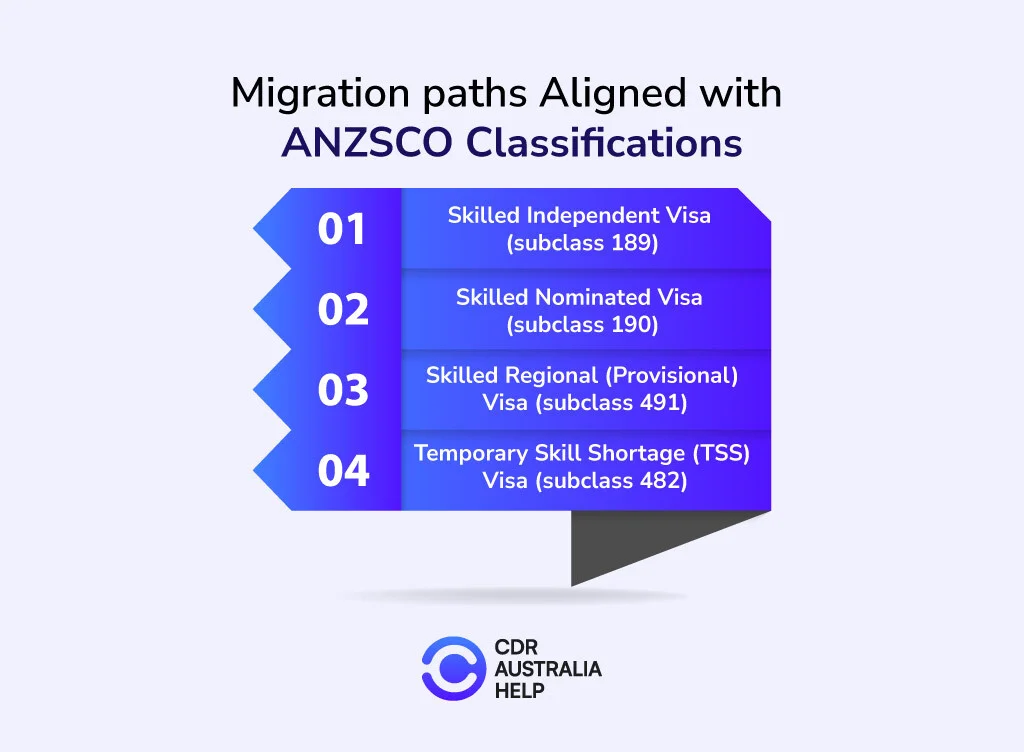
Australia and New Zealand offer multiple migration pathways for skilled professionals, many of which rely on ANZSCO classifications. Here’s an overview of the main visa options:
- Skilled Independent Visa (subclass 189)
As long as their occupation is listed on the MLTSSL and satisfies ANZSCO classification requirements, qualified professionals are permitted to live and work anywhere in Australia with this visa, which is based on a points system.
- Skilled Nominated Visa (subclass 190)
Candidates for this state-nominated visa must select a profession from a state or territory’s Skilled Occupation List. The occupation’s alignment with the state’s particular skill requirements is ensured by ANZSCO classifications.
- Skilled Regional (Provisional) Visa (subclass 491)
People who are willing to work in regional Australia are the target of this visa. Candidates must meet ANZSCO standards for their selected jobs, and eligible professions must be included on the Regional Occupation List (ROL).
- Temporary Skill Shortage (TSS) Visa (subclass 482)
This employer-sponsored visa allows skilled workers to work in Australia temporarily. Occupations eligible for the TSS visa are aligned with either the Short-term Skilled Occupation List (STSOL), MLTSSL, or ROL, based on ANZSCO classifications.
Selecting the appropriate pathway that aligns with ANZSCO classifications can simplify the application process and increase the likelihood of success.
Why ANZSCO Matters for Job Seekers and Employers
ANZSCO benefits both job seekers and employers by providing a clear framework for evaluating skills, qualifications, and experience.
Job seekers can gain insights into the requirements of their target roles, while employers can establish consistent standards when defining job descriptions and setting qualifications criteria.
ANZSCO’s structured approach helps bridge the gap between job requirements and candidates’ skills, benefiting the labor market.
How CDRAustraliaHelp Can Assist with ANZSCO Skill Level Understanding
Need help with ANZSCO Skill Level Classifications? CDRAustraliaHelp can provide reliable information and assistance. We can help you determine the correct skill level for your career path and understand the specific skill requirements.
Our experienced team can clarify standards and provide insights into credentials, job history, and training.
Navigating the ANZSCO skill level system can be challenging, especially when determining eligibility for skilled migration. CDRAustraliaHelp offers professional support to help you understand the nuances of ANZSCO classifications and assess your eligibility.
Our experienced team guides interpreting unit group requirements, matching your qualifications to ANZSCO skill levels, and preparing documentation for migration applications. With our expertise, you can confidently approach the skilled migration process and maximize your chances of success
Clarity about ANZSCO skill levels, unit groupings, and their importance in the employment and migration environment is the goal of this extensive book. To effectively navigate career and migration routes, it is crucial to comprehend these classifications, regardless of if you are an employer, job seeker, or prospective immigrant.
Our services include:
- Identifying the appropriate skill level for your career.
- Explaining the specific skill requirements for different occupations.
- Providing insights into the credentials, job history, and training associated with each skill level.
- Clarifying the evaluation standards used to assess skill levels.
We aim to provide clear and concise information to assist you in understanding ANZSCO skill levels and how they apply to your situation.
FAQs
1) What is ANZSCO, and how does it affect my migration to Australia?
Australia and New Zealand employ a systematic framework called ANZSCO, or the Australian and New Zealand Standard Classification of Occupations, to categorize different jobs according to their experience, education, and skill levels.
Understanding ANZSCO categories is essential for migrants because it allows them to assess if their line of work satisfies labor market demands in these nations, which may have a big impact on their eligibility for a visa and their possibilities for migration.
2) What does the phrase “ANZSCO unit group” refer to?
An ANZSCO unit group is a classification that organizes a set of related occupations sharing common job responsibilities, skill requirements, and tasks.
Each unit group offers a broad summary of the roles that fall under that category, which helps authorities and migrants understand the particular competencies required for different occupations.
One such unit group, for instance, is “Retail Managers,” which encompasses a range of managerial roles in the retail sector.
3) How is the ANZSCO skill level determined?
The degree of education, work experience, and on-the-job training required to do a particular vocation effectively are the basis for determining an individual’s ANZSCO skill level.
Skill Level 1 indicates highly skilled jobs (like professionals and managers), and Skill Level 5 indicates lower-skilled positions (like sales personnel and manufacturing process workers), according to the ANZSCO framework, which divides skills into five levels.
4) What constitutes Skill Level 1 in Australia according to ANZSCO?
The highest level in Australia’s ANZSCO categorization system, known as Skill Level 1, requires a bachelor’s degree or more in addition to a significant amount of professional experience.
This category usually includes professions that need a high level of knowledge and considerable training, such as medical professionals, engineers, and IT specialists.
5) How can I ascertain my ANZSCO skill level for migration purposes?
Compare your credentials, work history, and job responsibilities with the descriptions given for your relevant ANZSCO occupation to determine your ANZSCO skill level.
To determine if you fulfill the educational and experience requirements for passing skills tests and obtaining visa eligibility, it is critical to comprehend the ANZSCO skill level categorization.




